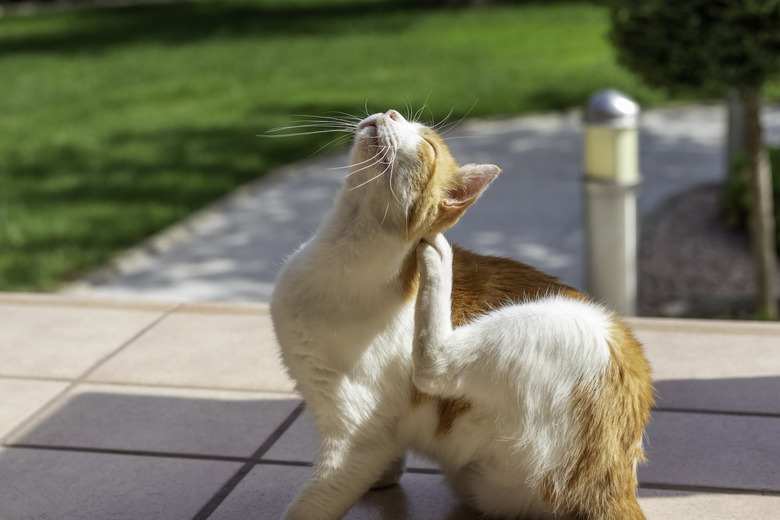What To Do If Your Pet Has Fleas
Fleas—they're the worst! An irritating pest that leaves pets and people itchy, an untreated flea issue can quickly turn into an infestation, so you'll want to get on top of it as quickly as possible before it gets terribly overwhelming. Flea control should be tackled from a number of angles so that all of the life stages of a flea are stopped in their tracks. This includes treating your pet, cleaning your home, addressing any side effects of flea bites and allergies, and taking preventative measures. If your pet has fleas, don't worry—you can get your furry friend and your home back in great shape with just a bit of work.
Identify if your pet has fleas
Identify if your pet has fleas
Fleas are most commonly found on dogs and cats, but they can also infest other pets, such as rabbits and ferrets. The easiest and earliest sign most people notice when spotting fleas is seeing their pets scratching at their own itchy skin. That's because adult fleas bite, which leads to an allergic reaction in most pets and people. To be sure, you can run a flea comb through your pet's hair, which will not only pull fleas off of them but also flea dirt, which are little black specks made of waste material and dried blood. You may also see small bite marks on areas like the belly, around the ears, or in any folds of the skin that are dark and moist—the perfect habitat for fleas.
In some cases, you may even notice flea bites on yourself, especially if you share the couch or your bed with a pet, or if the infestation is severe. Around the ankles and wrists are common areas where people notice flea bites, which appear as small, reddish-brown bumps that itch.
Problems that fleas can cause
Problems that fleas can cause
If you notice fleas on your pet or around your home, you'll want to take measures to get rid of them, as they only get worse over time. When left untreated, fleas can cause a number of problems for pets, including:
- Anxiety and restlessness. Fleas can make pets very itchy, leading to them scratching excessively. This can cause skin irritation, hair loss, and even open sores.
- Anemia. Fleas can suck a lot of blood from their hosts, which can lead to anemia in young, old, or sick pets.
- Transmission of diseases. Fleas can transmit a number of diseases to pets, including tapeworms, flea allergy dermatitis, typhus, and even plague! But don't worry, the latter is commonly only carried by rat and squirrel fleas.
The dog flea
The dog flea
Did you know that the fleas on dogs are not exactly the same as the fleas that infest cats? It's true! Dog fleas and cat fleas are not the same, but the difference between them is minimal (microscopic, in fact.) Both types of fleas are in the same genus, Ctenocephalides, but are technically different species— dogs are known as Ctenocephalides canis, and cats are known as Ctenocephalides felis.
The cat flea
The cat flea
If your pet has a flea problem, they most likely have cat fleas, regardless of whether they themselves are a cat, dog, rabbit, or other type of domestic mammal. Most North American flea infestations are caused by cat fleas. Dog fleas, on the other hand, are more common in Europe.
How to get rid of fleas
How to get rid of fleas
Getting rid of fleas on your dog, cat, or other household pet can feel overwhelming at times, especially if you have a bad infestation on your hands, but don't worry! There are tons of items on the market and additional solutions to help get your pet flea-free in little time.
Over-the-counter flea medications. Pet parents can find tons of effective flea control products over the counter at most of their favorite pet retail stores and websites, no prescription needed. These include medicated flea drops, chews, flea shampoo, flea spray, and even treatments for your home and yard.
Prescription flea medications. Some flea medications will require a prescription, including NexGard, and Bravecto. You can purchase these medications at your veterinarian's office, or you can order them online with confirmation from your veterinarian's office.
Veterinary care. If your pet has a severe flea infestation, you may need to take them to the vet for treatment. These treatments usually include flea removal with medication, as well as any necessary medication and treatments for side effects, including flea allergy dermatitis.
Flea treatment for your home
Flea treatment for your home
Treating fleas on your pet is only part of the solution when you have a serious infestation in your home. Due to the flea life cycle, fleas can multiply rapidly, especially once flea eggs have been laid. From there they turn to larvae, then pupae, and then adults, which go on to lay more eggs, keeping the cycle, and thousands of fleas, alive. For this reason, you'll need to exterminate fleas and their eggs as quickly as possible, which can be done by following these steps:
- Vacuum and wash your home thoroughly. This includes vacuuming carpeted areas, as well as fabric surfaces like couches, chairs, and curtains, and washing flat surfaces like floors, floorboards, and wall trim. Take extra care to clean heavily-frequented areas of the home, like near doorways, common hallways, and especially the area where your pet spends a lot of time, like near their bed, kennel, or food and water dishes. Washing clothing, bedding, and towels in hot water and drying them on high heat will also remove fleas and flea eggs. After you've vacuumed, empty the canister or vacuum bag outside in a trash can, and wash or wipe down the canister and vacuum.
- Dispose of any flea-infested items. If you know that something is infested with fleas, it's recommended that you toss it, especially if it's fairly easy to replace. This can include door mats, your pet's bed, cat condos, fabric toys, collars, and leashes. Place them in a plastic garbage bag, seal the bag, and dispose of it outside of the home.
- Use a flea fogger or spray. It's extremely important to understand that fogger pesticides are NOT safe for pets, and it is important that you not use them while you or your pet in your home. In fact, it's recommended that you and your pet not enter the home for eight hours after a flea bomb has been used, so this step is really only recommended for serious flea infestations when done in combination with the above steps. If you do use a flea fogger, be sure to read all directions and warnings, including removing your pet's food and water (along with the dishes) from the home. For a natural solution, consider using diatomaceous earth for fleas.
How to prevent a flea infestation from coming back
How to prevent a flea infestation from coming back
The best way to treat fleas is to keep them off your pets and out of your home in the first place, which can be done by taking a few easy preventative measures.
- Keep your pet's fur clean and trimmed. Regular grooming will not only make it harder for fleas to infect your pet, but it will also make spotting them early easier for you, which will give you the best shot at effective flea removal. Using a flea shampoo every time you bathe your pet isn't necessary or recommended, but it is a great first step in flea control if you notice fleas on your pet.
- Use a flea collar or other topical flea treatment on your pet. Flea collars can keep fleas off your pets, but only around the immediate area where the collar is placed (around the neck and head.) Monthly flea treatments are a great way to prevent fleas, especially during the warm months when fleas are alive and active. You can also find flea prevention in the form of chewables, which take effect quickly and work from the inside, out to keep fleas away.
- Vacuum and wash your home regularly. Much like keeping your pet clean, keeping your home clean will go a long way in keeping fleas at bay. If you have pets that go outdoors, regular vacuuming, dusting, and mopping is a great line of defense against flea infestations. Additionally, keep your pet's bedding, collar, and leashes on a washing routine, along with your own clothing and bedding, especially if you share your bed with your pet.
Most bugs are attracted to food sources, like dog food or cat food, but what about fleas? Do you need to remove any potential food sources for fleas? Fortunately, no. Fleas feed on warm-blooded mammals, so while they will attract fleas, their food won't. That said, because your pet is their food source, take extra care when letting your pet roam in tall grass or known flea-infested areas, especially in warm climates, to prevent flea contact.
The bottom line
The bottom line
Fleas are certainly a nuisance, and if you have a pet who ever leaves the house, chances are you will come into contact with them at some point. That said, you can prevent flea infestations by keeping your pet and your home clean, and by giving your furry friend preventative medication that keeps fleas away, like flea drops, chews, or flea collars. If you already have fleas on your pet and in your home, medicated treatment is essential, as is thorough and repeated home cleaning, which includes washing clothing, bedding, and other fabric materials.





